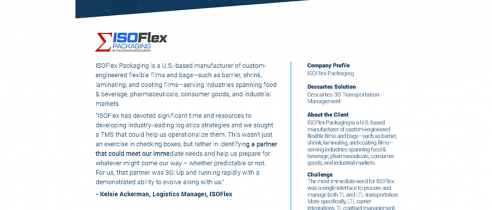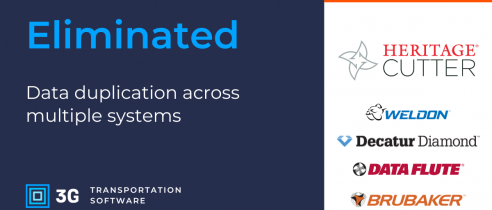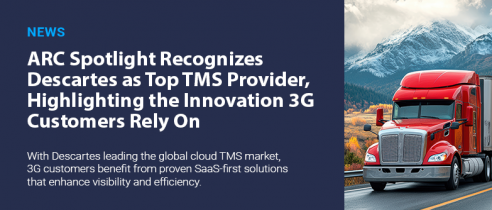The hype around blockchain is subsiding, and in its wake the transportation industry is taking a more serious look at how blockchain could be leveraged to improve operations.
In this interview at Talking Logistics, J.P. Wiggins discusses the positive impacts blockchain could have on visibility and efficiency – especially for mom-and-pop carriers. More than a half-million carriers have six trucks or less and don’t have modern ways of tracking freight with a TMS. Blockchain could address this huge gap by providing ways for small carriers to improve visibility and share data with transportation management systems and others.
Check out this engaging interview to learn more about blockchain’s possibilities for carriers, the biggest hurdles to making that a reality, and how this shift could positively impact the GDP of the entire United States.
Visibility-Driven Workflow for Transportation Execution Transcription
Hello and welcome to Talking Logistics, where we have conversations with thought leaders and newsmakers in the supply chain logistics industry. It’s my great pleasure to welcome back JP Wiggins, co-founder and vice president of logistics at 3G TMS. Today, we’re going to talk about visibility-driven workflow for transportation execution.
We talk about visibility a lot in supply chain and logistics. It’s almost become this amorphous term, untethered from business reality or processes. We all want more visibility, but what can we get from it? How do we derive value from visibility and convert it into business benefits? These questions are particularly relevant in transportation, where making smarter, faster decisions is crucial in today’s environment of rising costs and demanding customer expectations.
In this episode, we’ll explore visibility through the lens of transportation management, processes, and technology. It’s always great to welcome JP to the program to share his insights and advice on this topic. JP, welcome to the program.
JP: Thanks! Glad to be back.
Host: JP, a lot of times I hear supply chain executives say, “If I can track an Amazon package on my phone or see an Uber driver making their way to me in real time, why can’t I have the same visibility for my truckload or LTL shipments?” But the reality is that B2B visibility is more complex than B2C. What makes it more complex?
JP: In the B2C world, like with Amazon, it’s a controlled environment. Customers ask, “Where’s my stuff?” and Amazon can provide that answer because they control the entire process, often within a single mode of transportation. They invest heavily in this capability—billions of dollars annually. You can even ask, “Alexa, where are my lights?” and you’ll get an immediate answer. But in B2B, it’s much more complicated.
In B2B, you need to know more than just where something is in transit. You need to track it across the entire supply chain process—from order management to warehousing, and through multiple modes of transit. A single order might be split into multiple shipments, or multiple line items might be traveling on different modes. You may also be dealing with third-party vendors, 3PLs, carriers, and even in-house fleets. In the 80s and 90s, we called this approach a “control tower,” but I don’t like that term anymore. Today, companies face the challenge of providing visibility across this entire, complex process for their customers.
Host: That’s a great overview, and it really paints a picture of how complex it is. You’re dealing with multiple modes of transportation and multiple parties—your company, 3PLs, carriers, and even suppliers. You need visibility not only of the shipment itself but also where it is in the warehouse and even upstream in the manufacturing process.
Let’s dive into transportation visibility specifically. How has it improved over the years, and what challenges remain?
JP: The good news is that things have gotten better. Across your entire supply chain, you have order management systems, warehouse management systems, and third-party systems that are providing real-time updates. Your ERP system can tell you where orders are, your warehouse system knows the status of inventory, and even finance systems can provide visibility into payments and credit limits. But the challenge is that each system speaks a different language—order management speaks orders, finance speaks invoices, and carriers speak shipments. It’s not a one-to-one relationship.
In the 90s, we tried to solve this with enterprise application integration tools, but no one has the time or budget for that now. Instead, your TMS (Transportation Management System) is doing the heavy lifting. A modern TMS integrates with your ERP, carriers, and third parties. It manages data like ship dates and delivery windows, and it pulls everything together to create a comprehensive visibility project.
Host: It’s interesting that you mention how TMS brings all these pieces together. What are some key TMS features or capabilities that companies should look for when trying to enable transportation visibility?
JP: Integration is key. No one wants long integration projects, so it’s important to have simple, effective integration with both internal systems and external partners. You also need good workflow capabilities. It’s no longer just about management by exception because, frankly, everything is an exception now. You need workflow automation to proactively respond to problems.
The TMS should also provide real-time data and the ability to react to disruptions. For example, if a truck is delayed, you should know whether that’s a big deal for your business or just a minor inconvenience. You need to know how to escalate the situation based on its impact.
Host: I love that line—“exceptions are now the norm.” This ties into machine learning and artificial intelligence, doesn’t it? These technologies can help automate workflows and decision-making, right?
JP: Absolutely. We’re working on a combination of machine learning and capturing the logistics planner’s thought process. A planner can set up workflows for specific scenarios, like what to do if a truck is delayed or if inventory isn’t available. You can build workflows to handle disruptions, automate tasks, and even change modes of transit on the fly. It’s all about letting the system handle the complexity while still incorporating human expertise.
Host: Can you give us some examples of transportation workflows that visibility can enable? How do companies ultimately measure the benefits?
JP: One common example is defining what “on-time” means. Does it mean arriving at the dock at the agreed time? Or is it about hitting a customer commitment time? With real-time tracking, you can measure things like detention charges—if a truck sits at a customer’s dock for hours but hasn’t been unloaded, you can track that and prevent unnecessary charges.
Overall, visibility allows you to track the entire delivery process, from order placement to final delivery and payment. The key benefit is improving customer satisfaction by proactively managing disruptions and keeping costs in check.
Host: That’s a great point. In addition to cost savings, there’s also the labor component—doing more with the same number of people. And of course, improving the customer experience by offering real-time updates or fixing problems before they affect the customer.
JP: Exactly. In industries like food, where visibility is critical for maintaining cold chain integrity, customers demand this level of visibility. It’s also becoming common for 3PLs to offer this extended visibility to their shippers. If you’re a 3PL and can’t provide this, your competitors will.
Host: JP, we’re running short on time, but one final question—what should transportation executives ask themselves to assess whether they have the right capabilities in place to enable transportation visibility and achieve the greatest benefits?
JP: Don’t just focus on tracking where your trucks are—that’s only one part of the puzzle. Look at the bigger picture. B2B visibility challenges can be solved, just like we’ve solved them in B2C. The technology is there, and it’s working in the real world.
Host: JP, this has been a great conversation. I think we’ve just scratched the surface, and we may need to have another episode to dive deeper into TMS and its evolving role in supply chain logistics. Thank you again for your time and insights today.
JP: Thanks! Glad to be here.
Host: And thank you to our audience for joining us. If you’re watching this episode on-demand and have a question for JP, feel free to post it, and I’m sure he’ll be happy to respond. We look forward to seeing you on a future episode of Talking Logistics.





